index memoir -
homepage - contact me at
I left Paris in mid September, and landed at Kai Tek airport[2] in Hong Kong after the plane had skimmed alarmingly close to the tops of surrounding skyscrapers. Permits to enter China were arranged within a few days and a group of us took the modern electric train to Lo Wu, the terminus just on the Chinese Border. We passed through both Hong Kong and Chinese immigration and customs into Shenzhen, a rapidly expanding border city - rather shabby, but with modern buildings springing up. In the earlier tense cold war Maoist days this had been a fortified border with gun emplacements, barbed wire fences and searchlights and little if any traffic passing then. It was difficult to imagine this now.
On later occasions during Chinese New Year and other holidays the crossing in both directions was very busy. Many H K people had been refugees from China before 1980 and had been allowed to stay if they had a job. Hong Kong had impressively housed most of it’s inhabitants in high rise towers and virtually all slums and shacks had disappeared. Cross border family ties remained strong. We were carried along the station platforms by a sea of people, many carrying bulky red, white and blue striped woven plastic hold-alls. Some ‘fat’ peasant women were rumoured to have cuts of pork strapped to their bodies to evade customs when entering Hong Kong. Bringing fresh produce into China was also not allowed - we risked having foreign fruit confiscated by the Chinese customs, who, we sourly thought, would enjoy eating it. Later a non smoking British expatriate brought in foreign cigarettes whenever he crossed – sometimes twice in a weekend. He boasted that he sold them at a profit to local Chinese people – surprising as he was earning a generous salary.
The journey from Hong Kong to the site took about 3½ hours, the part in China being by car or company bus. Early on we obtained multi-entry visas to make crossing at any time possible, but our large blue hard-covered 90 page British passports filled up rapidly with date stamps. Ultimately Cubby had to get a new one[3] at the H K passport office and was thankful that she qualified for right of abode in the U K. Most Chinese Hong Kong citizen’s British passports restricted this. Many educated Hong Kong people, in anticipation of the return of their Colony from Britain to China in July 1997, crowded the passport office. They intended emigrating – Canada and Australia seemed to be favoured destinations. Some wanted to return to H K but with a foreign passport as an insurance policy.
Our future homes in a compound on the edge of the sea at Daya Bay, the site of the Plant, were still being constructed. We were temporarily housed in a modern hotel, Sui Mui Sha, on the coast about half way between Shenzhen and the site. It was rumoured that the hotel had been built as a ‘Club Mediterranean’ type resort intended for foreign holidaymakers, but permission for a rapid direct Hovercraft link from Hong Kong had been refused and tourists did not materialise. Some of Campenon Bernard’s expatriate wives and families were already staying there, arriving in the belief that housing and schooling would be provided as originally scheduled.
Each day, I commuted the ¾ of an hour from the hotel to the site in a company bus over a bumpy and dusty road being reconstructed. Along much of the road Guangdong’s coastal mountains were being cut down and platforms pushed into the sea for future container ports to avoid shipping through H K. We spent long days on site, leaving the hotel at 6-30am and returning at 7-00pm, but fortunately only worked alternate Saturdays and had Sundays free.
In the evenings we relaxed either in the hotel’s western coffee shop or its Chinese restaurant or at the several eateries (generally small shacks with tables in the open air) close to the hotel. Good Chinese food was available at cheap prices (35HK$[4] for two persons - approximately £3) for the freshest of shrimps, calamari, fried rice, green vegetables and thirst quenching Tsing Tao beer, a good light German type brew. If you were squeamish you looked away when fish were taken out of tanks and first thumped then cut on the floor. Nor did you look to see if vegetables were washed after being cut by squatting helpers – but we never suffered any stomach problems. When typhoon storms threatened we often ate by candlelight - these shacks unlike the hotel had no standby generators.
On free days we played tennis on the hotels hard courts or strolled down to the sandy beach and swam in the sea. The hotel’s pool surrounded by waving palms was half empty and green and sludgy. From time to time we would go on a gruelling day trip to Hong Kong to buy essentials or to make telephone calls abroad. Some people had obtained mobile phones (then a fairly new innovation) linked to Hong Kong’s network and used them in China illegally. Reception was more reliable than the Chinese land network. I welcomed the arrival of my first Guardian Weekly sent like all our mail first to the HK office and then taken to site. I would now know what was happening in the world albeit a week late.
The office on site was a shambles, photocopying machines were often broken down, typists were not available, internal phones not installed, desks were too small apparently reflecting person’s status rather than actual job needs – all this after some time improved once bureaucratic obstacles in and between China and Hong Kong and within the site organisation were circumvented. Office resources had also been underestimated - within months a second story was added above the original concrete roof.
Campenon Bernard, to whom I had been seconded by Spie Batignolles, were the leader of a civil works construction joint venture (HCCM) with two Chinese partners -Hua Xing and SBC and a Japanese company Maeda. Maeda’s main area of work was the Conventional Island – Turbine Halls etc while Campenon’s field was the Nuclear Containment etc. The two Chinese contractors in effect supplied, housed and directed the large numbers of skilled labour generally recruited from areas outside Guangdong Province. They did the physical work following methods and procedures set by expatriate staff. The Chinese partners also ensured that there were no unforeseen wage demands reducing profits.
Campenon’s first Project Manager had left the site apparently for domestic reasons before I arrived and his deputy had taken over. Within a few months, he, found wanting by his head office, was replaced by a third more senior Project Manager who stayed to the end of the project. In addition to expatriate staff largely from France and Japan (with a sprinkling of Britons), Campenon and Maeda employed some H K Chinese personnel as engineers, foremen, and secretaries. Later Chinese staff was recruited from Singapore – a knowledge of Mandarin Chinese being more useful than Cantonese. Although the job was in a Cantonese-speaking province, the labour and their managers, from areas outside Guangdong Province, spoke different dialects or Mandarin. China had adopted a revised language script some time previously. While Singapore also followed this, ‘colonial’ H K had not - and their people now found this script difficult to read let alone write.
My first office assistant was a young Frenchman who in effect was doing his National Service within a civil company rather than the army – it seemed a good system giving youths a chance to travel albeit probably on low wages. He was a cinema enthusiast and bought a player for films in HK - effectively outsize CD disks. The smaller DVDs first appeared some years later. When he left towards the end of 1988 a Singaporean was employed as my assistant.
Some of Spie’s staff, seconded to Campenon on this project, had worked on both the South African Koeberg Nuclear Power Plant and on the Korean KNU 9&10 project. This was the third nuclear plant both for me and New Zealander Ray Cummins. Olivier Mordret, who had also been on Koeberg, had stayed somewhat longer in South Africa on the construction of the Hex River rail tunnel blasted out of rock leading onto the Karroo plateaux. It was refreshing to hear Olivier’s South African learnt English reminding me of trips into the Cape mountains with French and South African staff and families.
Several other French engineers who had also been in Korea, had been seconded from Electricite de France (EDF) to work for the Guangdong Nuclear Power Joint Venture (GNPJV) the Client. The Client was a consortium of H K and Chinese companies financing, building and controlling the project. Some of GNPJV / EDF’s staff were still living in Shenzhen and faced a very long journey to and from the site daily until their own compound virtually next door to the site was completed. Their apartment blocks were not very attractive and Campenon and Maeda had decided not to house their staff there. An alternate site further away but closer to the sea had been found.
In the early days some of GNPJV’s staff seemed to lack confidence in Campenon’s ability as an overseas contractor. This was not helped, when despite a Quality Assurance Program meant to prevent significant errors, major quantities of rebar were left out of a section of the reactor’s concrete base. Hong Kong’s headlines in newspapers and TV blazoned this – there was vocal opposition to the nearby plant’s construction by some anti nuclear power activists. The defect was overcome by modifying the base design and the project continued. Later the unfortunate steelfixing foreman was fired taking the blame although the drawings may also have been at fault or misleading. Other parties had also probably done inadequate checks, but were not held to be directly responsible.
As Subcontract Manager I had thought that I would report direct to the Project Manager. Although it was an English Language contract, I was not a direct Campenon Bernard staff member and as such was probably viewed as a non French-speaking outsider. I found myself placed under the Technical Manager – effectively at a lower level than I had anticipated and was limited in my ability to influence management decisions and policies. This influenced my decision to stay only for the two years of my employment contract rather than extending it. In hindsight a rather foolish decision as the money earned was good and life socially not unpleasant.
I gradually got to know the specialist French subcontractors employed by HCCM on the Nuclear Island for the containment steel lining (and other structural steelwork), the post tensioning of the concrete surrounding the lining, and for the anti nuclear contamination painting of both the steel lining and other concrete works. The site subcontract manager for the post tensioning works, also staying in the hotel, was a fairly young engineer who had also worked on the NPP in South Korea. Tragically a cancer, for which he had previously undergone a major operation, re occurred after his arrival and he, his wife and two good looking sons returned to France.
The subcontracts had been drafted in English and signed earlier in Paris by Campenon on HCCM’s behalf and were imprecise in some respects. Niggling items such as the cost of housing provided to the subcontractors had been omitted. More seriously responsibility for various process interfaces arising between subcontractors and the main contractor were often not defined and required further clarification in order to avoid later claims. The managers of these French subcontractors spoke good English, were generally efficient and all in all did a good job with little hassle.
Meanwhile before I could get a residence permit, I in common with all expatriates, was taken to a Chinese Hospital to have a sample of blood extracted for an AIDS test. Rather optimistically, as one can see now 15 years later in 2002, the Chinese Authorities hoped to prevent the entrance and spread of AIDS in China. But the puritan sexual culture in communist China relaxed with some unfortunate effects when both free enterprise and prostitution returned. We were also examined to ensure that we were fit to get Chinese driving licences.
Cubby left Langeland and returned to our Paris apartment to pack some tin trunks for the site. She then visited Andrea in her last year at school in Milton Keynes. Andrea decided she did not wish to go to University but wanted to train as a carpenter. Later Cubby visited Sheffield where Chippy and his then partner Beth Anne lived in their recently acquired terrace house. The electricity had been rewired but they were still cold without central heating and reliant on gas fires. Beth Anne had obtained a job but Chippy, despite his good university qualifications in Russian and French, was not so fortunate. He was in effect for some time a ‘house dad’ looking after their son Toby, but also became a competent cook.
Cubby arrived in Hong Kong near the end of November 87 about the time typhoon Nina passed. Nina had devastated large parts of the Philippines but affected south China less severely. The only damage we saw was a roof blown off one of the restaurant shacks near the hotel. H K had an effective system of typhoon warnings grading them by severity virtually hourly. Only when a certain level was predicted were precautions taken such as taping windows, placing sandbags to keep out the sea, curtailing journeys and staying at home. Regular H K people took the warnings in their stride but newcomers not having any experience were nervous.
On this occasion the temperature plunged to 6,5C cooled by winds originating from Mongolia and our staff rushed into H K to acquire coats and pullovers. Later it warmed up somewhat reaching 20C, sufficient for Cubby to swim near the hotel.
By this time some of the French families had moved to houses completed in the compound. On enquiring belatedly (I had foolishly put work ahead of comfort) I found that we had not been allocated a house but a one bed roomed apartment too small to house our son Benjamin when he visited on School holidays. I had made the mistake of not specifically mentioning this in my employment contract or alternately, as some French couples were reputed to have done, provided a doctor’s certificate endorsing the need for them to have separate bedrooms for health reasons. In the end after protesting we were allocated a single storied house, in a terrace of four, literally on the sandy edge of the sea set amongst casuarinas pine trees, but could only move in when this was completed. All the homes were provided with pleasant furniture from IKEA. In addition families were allocated an allowance (HK$5000 in our case) to permit purchase of personal bedding, crockery, kitchenware etc.
The new Project Manager had a very large house designed and built for his wife and his children. Some expatriates carped at this calling it ‘The Palace of Versailles’, but all other large houses were already occupied and apparently the P M would put up important visitors to site. Generally bed sitting rooms were provided for single staff from Europe, H K and elsewhere. In a small expatriate community with wives with time on their hands and expatriates sensitive to whether they were being fairly treated, gossip and back biting were rife – this seemed to occur on all large projects especially ones with a housing compound. Living away from a site was generally preferable but not possible on this project.
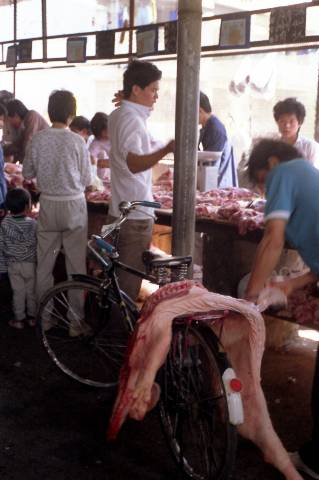 |
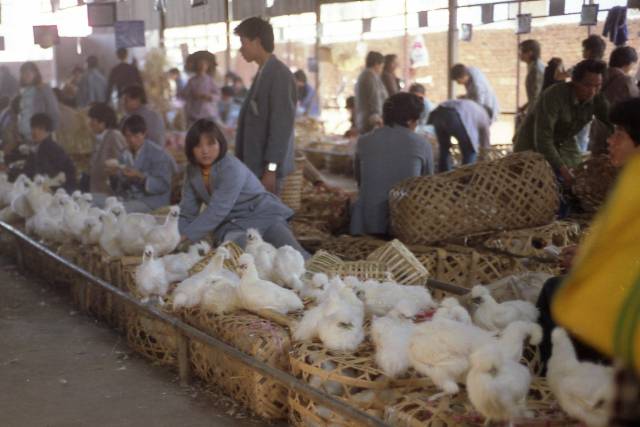 |
Thriving market at Shenzhen |
|
Cubby, bored at the hotel, ventured on her own into Shenzhen by bus to get a hair cut and to see what local goods were available. Although the people did not speak English they were friendly and good-natured and she felt quite safe. She had a headed piece of hotel notepaper in Chinese to show to bus drivers, but after catching several buses and arriving at unknown terminals she returned to the hotel by taxi. Taxis, plentifully available, seemed to have been purchased 2nd hand from H K and often belched black exhaust smoke. These taxis, made for driving on the left in H K, now in China had their steering wheels on the right near the kerb – only foolishly intrepidly passengers sat in front risking injury should collisions occur.
On trips into Shenzhen we found that phalanxes of bicycles were used to get to work and these had to be carefully avoided when crossing the road. Indeed there were more bicycles with jangling bells than motorised vehicles, but this seemed to have changed when I passed through Shenzen about 8 years later - cars seemed to have literally driven bicycles off the road.
Shenzhen district had an internal boundary around it on roads entering the city. We frequently crossed an internal border post lying between the hotel and the site and would have to show our passports unless identified as foreigners and waved on. Only Chinese persons from outside provinces who had been authorised could enter and work in Shenzhen. Shenzhen was a magnet for workers in the factories being established by entrepreneurs from H K, Taiwan and elsewhere. They lived in dormitories near the factories and had little free time. It was rumoured that there were fires from time to time and workers locked in dormitories with burglar bars could not escape.
In Shenzhen we came across a ‘food’ street with endless restaurants mostly with two to three tables in the open air. Their wares on offer were alive in cages stacked on the road edge ready for slaughtering – eagles, owls, pigeons, pheasants, white chickens with fluff down their legs, dogs, cats, racoons, badgers, civets and porcupines – all looking forlorn. There were also baskets of entwined sluggish snakes and tortoises. Tanks bubbled with every conceivable type of sea animal. Eventually we ate at a more sedate restaurant in a large modern shopping arcade - there were no live animals to shame our carnivorous appetites. We sympathised with older Chinese people new from country districts hesitating or balking from stepping on moving escalators.
Just before Christmas Ben arrived for his school holidays – Cubby now had some company in the hotel. Escaping repetitious background music ‘Jingle Bells’ and Rudolf the Red Nosed Reindeer’ which pervaded the public rooms, they often sipped hot jasmine tea in tumblers in the bedroom. From the room balcony on clear days H K was visible in the distance across the water enticing them to visit several times and replenish rapidly growing Ben’s clothes. On the beach, sitting on clumps of round boulders in sunshine or cold, Cubby would write letters to her parents and our children.
For Christmas Eve we went to one of the local restaurants close to the hotel. As unsurprisingly no Danish roast duck or red cabbage was available we enjoyed shrimps, fried rice (inevitably pronounced ‘flied lice’), steamed lettuce and sweet and sour pork. We tamely topped this off with tinned litchis. Our yearly ‘ris al’amande’ was not available (rice and ‘almond’ a traditional Danish dish of rice boiled in milk until it thickens – sugar and ground almonds are stirred in and one skinned almond added. The person who finds the almond hides it in his mouth until all the pudding is consumed. Stuffed diners are then challenged and the almond confessor wins a prize).
Christmas day, I worked on the site – it unsurprisingly was not a gazetted holiday in ‘atheistic China’ where there were actually many religions. That evening we ate an 'English' Christmas dinner at the Hotel accompanied by endless repetitions of ‘Frosty the Snowman’ and a bottle of palatable but overpriced Chinese Dynasty white wine. Many Chinese people visited the hotel to sample an English celebratory meal and some were served a cubic inch of Christmas pudding before their turkey. Some unfortunates received no turkey afterwards. We found the meal somewhat boring compared to our earlier simpler Chinese meal.
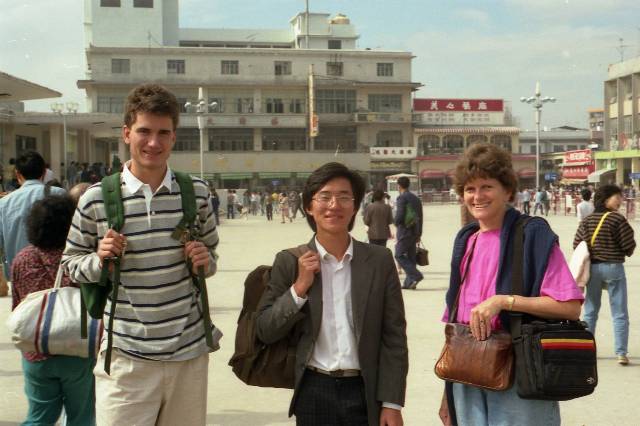 |
|
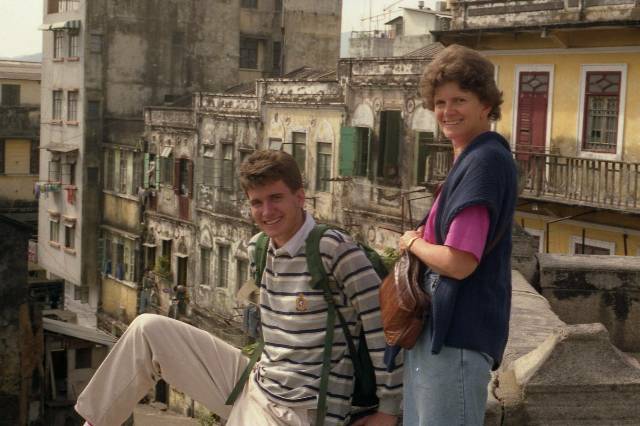 |
|
Visit to Macau |
|
The next weekend we ventured to Macau. Arriving in Shenzhen, Cubby drew a picture of a boat and showed this to a taxi driver hoping to be taken to a ferry terminal at Shekou. Instead we arrived at what appeared to be a ocean going liner only to find that it was a local attraction made of concrete. On the coast, north west of Shenzhen, a ‘Chinese Blackpool’ was being built - large hotels and amusement areas, lakes with traditional arched bridges, incongruous Bavarian Castles, funfairs, go-cart racing and convoluted pools unsuited to Olympic swimming. Eventually we found another taxi, reached Shekou and boarded a hydrofoil going to Zhuhai. Escorted by a friendly Chinese student who spoke good English, we passed through immigration and walked some distance into the then still Portuguese administered Macau.
Cubby and I had visited Macau in 1985 and it still retained it’s colonial charm. Unlike H K, old buildings had not yet been ruthlessly demolished by progressive vandals and replaced by skyscrapers, nor had land reclamation despoiled the natural coast. Even the gambling casinos did not seem to be too brash. We walked Benjamin along old narrow streets festooned with draped electric cables and climbed up to the old fort and the impressive baroque façade of the long burnt down cathedral. It looked in our opinion almost South American.
Descending we arrived in the town square with its old cast iron fountain. Aged Chinese women dressed in Portuguese black were sitting on benches and vendors were selling fruit. On the square we found a restaurant and had a first class Chinese meal on starched white tablecloths accompanied by chilled Matteus Rose. We decided this was our real Christmas celebration. We returned late in the evening to Sui Mui Sha hotel travelling by ferry to H K rather than Shekou. We squeezed onto the train to Lo Wu jammed with people returning from visiting relations and friends in H K – we could not find any seats and had to stand.
The following Sunday Ben and I joined a group led by Oliver Mordret climbing close by mountains. Through the mist we had occasional glimpses of beautiful valleys and villages below. Within a few days Ben returned to Denmark. We now hoped to move into the housing compound by the end of January 1988.
As there now was a canteen at the housing compound, I ate lunch there and checked progress on our house. Everything appeared to be going well when suddenly the kitchen cabinets hung on the walls disappeared. They were required for our neighbours who had arrived with a young child. I continued ferrying goods stored in our hotel bedroom to our house and as soon as a refrigerator and stove had been supplied we moved in on 13th of February 1988. We sat content on our sofa and gazed at the turquoise sea and the craggy mountains across the bay.
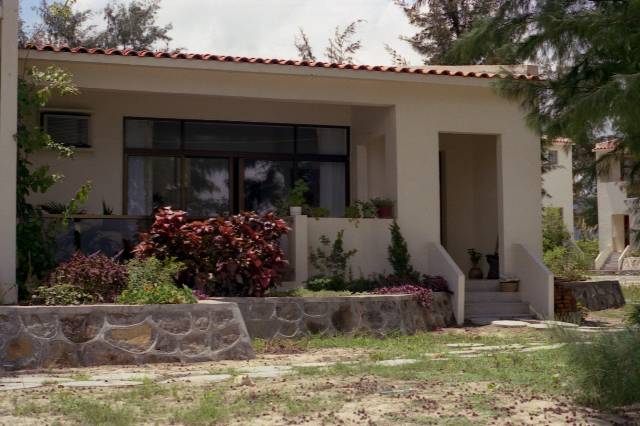 |
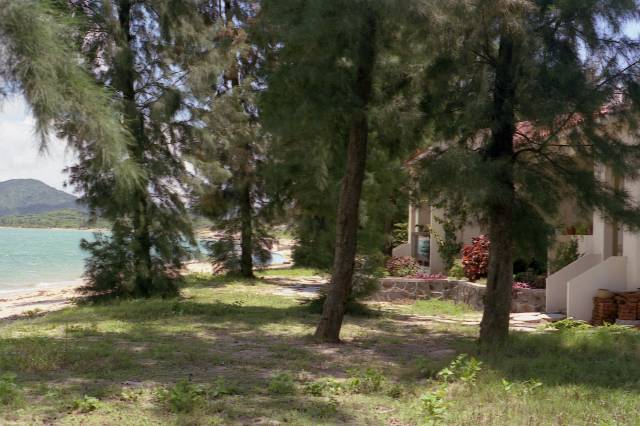 |
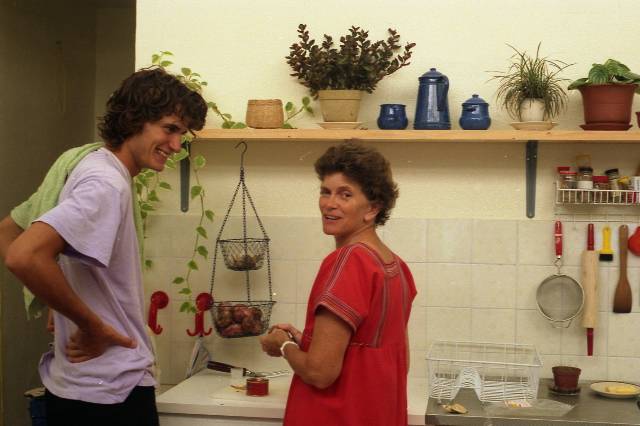 |
 |
Picture of our waterfront home once well established with gardens. Ben on holiday from Denmark in kitchen with Cubby. View of tranquil sea with fisherman in front of house. |
|
But not for long, Chinese New Year, the Year of the Dragon, was upon us. The Chinese have a cycle of 12 years named after animals and you were typed according to your birth year – you were either ‘rat’, ‘ox’, ’tiger’, ‘rabbit’, ‘dragon’, ‘snake’, ‘horse’, ‘lamb’, ‘monkey’, ‘cock’, ‘dog’, or ‘pig’. I, born in 1937, was a ‘ox‘ and Cubby, born in 1939, was a ‘rabbit‘ – not inappropriate names for parents with five children.
Fearing, erroneously as it turned out, that we might not be in our house and would have to spend a dull weekend at the hotel, we had booked a package holiday (the first we had ever been on) to Chaing Mai in Thailand while the site was closed down. Appropriate to the year, the group mainly middle class H K people (most of whom spoke English) flew direct to Chaing Mai on a Dragon Air flight avoiding the hassle of changing in Bangkok. We had already seen polluted Bangkok in the early 1980s when I was working in Malaysia
We ventured out daily from our pleasant hotel after hearty buffet breakfasts – American with hash brown potatoes (this feature distinguishing them from more familiar English ones) or Oriental. I often ate parts from both – noodles with shrimps and bits of meat from the oriental menu were always inviting. We wondered if the hill tribe village women, dressed in national dress finery, worked in crop fields – how practical was this dress? Was the old Chinese man smoking opium in a hut a genuine addict? Or were these ‘shows’ pre arranged. The raggedly, snotty and dirty children about the village in contrast seemed authentic. But the countryside was beautiful and fruitful with fantastic flower gardens. Our guide informed that the royal family had encouraged farmers to switch from growing opium poppies to more acceptable but less lucrative crops. Indeed seeming to emphasise this patronage, we were held up by a 15 car motorcade with motorbike escorts - the Royal Families winter palace was in the vicinity.
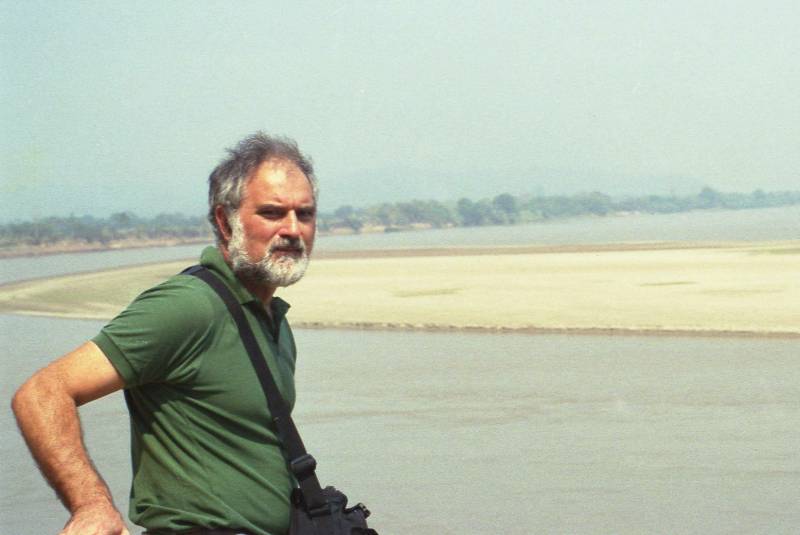 |
Me overlooking an island at the Golden Triangle |
We journeyed in an old bus, uncomfortable and sweaty as the air conditioning broke down, to the Golden Triangle, a sandy island in rivers on the borders of Thailand, Laos and Burma – interesting getting there but not much to see as the water was high and the island had shrunk – a bit of an anticlimax. We fed elephants bananas and sugar cane and then saw them put through their paces by their relaxed mahouts - logging and bathing in the river. Despite this being a theatrical performance for tourists, we could not but be charmed by these friendly giants. We were a little disappointed in the Thai dancing during an evening meal – it was less magical and vigorous than that which we had seen in both Bali and Yogyakarta in Indonesia.
Back in H K, in a Kowloon hotel on the sea wall edge, we, as an unexpected bonus, saw from our room the impressive New Year’s fire works display over the straits illuminating H K Island skyscrapers in the background. The next day we laboured back to China.
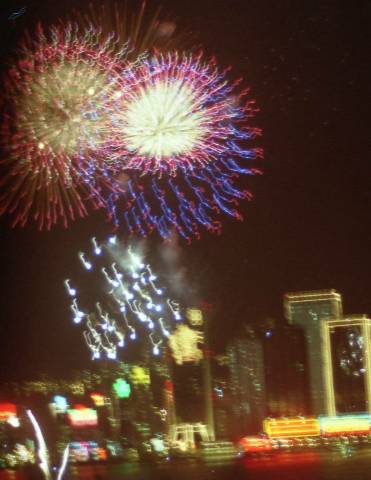 |
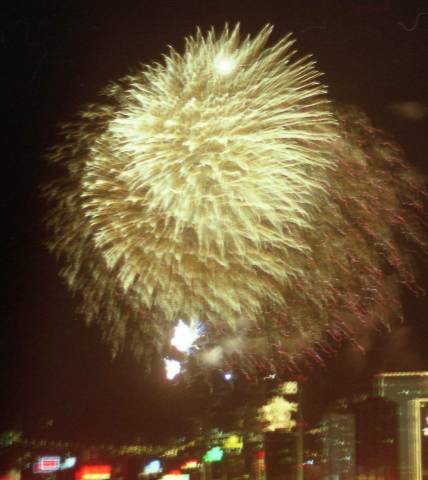 |
Fireworks display as seen from hotel on Kowloon waterfront |
|
One weekend shortly after our return from Thailand we went on an excursion arranged by GNPJV through the French Council in Guangzhou (previously called Canton). About 50 of us set out in two buses towards Mount Luofu about 150km from Shenzhen. Our journey in the second bus almost ended in disaster as we struck a lorry coming towards us while on a bridge. Glass pellets from the shatterproof windscreen showered us but no one was hurt except a passing cyclist who landed shocked down a bank and was later carted off by a pick up serving as an ambulance. We piled out quickly fearing fire and found the bus front inches away from the balustrade and from tumbling into the stream about 10 meters below. The lorry had jack-knifed blocking the bridge and we could go no further. A traffic jam developed on both sides of the accident. Fortunately the first bus had stopped further on and they would drop their passengers at our destination and then return for us.
We, about 20 foreigners, walked, carrying out motley rucksacks and baggage, for about a kilometre until we reached a tiny restaurant and a much used local canvass pissoir. Two tiny chickens were duly caught and dispatched, fluttering and jumping around without their heads. The chickens were served with spring onions, an omelette and boiled rice and lettuce. We felt replete and then continued walking - just reaching the end of the now even longer traffic queue when our second bus returned and took us to the recreational spa where we were to spend the night.
That afternoon we visited an impressive pre Ming dynasty Taoist temple. This unlike most temples had escaped demolition by Red Guards as the Chinese army had lived in and occupied this area during the Cultural Revolution (indeed we had noticed on the borders of our site that new temples or shrines were now being built by fishermen – presumably replacing earlier destroyed ones). The complex had apparently been developed to accommodate visiting Russian army personnel. Russians had stayed there until the schism between the two countries in the 1960ties. The Chinese army had now also left and the compound was now being redeveloped. Large bungalows, carpeted and air conditioned, previously occupied by senior officers, including Generalissimos and Field Marshals, were been done up for hire to visitors.
We were housed in what must have been a junior officers’ mess. Our high ceiling tiled floor bedrooms appeared damp. Only one clean sheet was provided for each single bed so we doubled up remaking a bed with two sheets to neurotically avoid touching blankets. The bathroom had a large tiled bath pit, cracked wash hand basin and toilet bowl and everything was green with moss. The towels provided were the size of wash hand cloths and only cold water ran from the taps. We did the barest of ablutions before retiring.
The next day we drove through misty evergreen forests on a dirt track over river fords and through hair pinned bends up the mountain to the site of a future Buddhist temple (to be funded by some H K millionaires). A huge white statue of a female deity already stood in a concrete lotus protected by ceramic dragons in a pretty valley leading to grottos and cascades.
Spring 1988 arrived, one Sunday unlike most previous days it did not rain but it was still grey and windy. We took a pleasant walk on the hills behind our housing compound and photographed the whole bay and the dimly seen islands at its mouth. The hills were largely covered with bracken just beginning to show green fronds amongst the dead areas of the previous year. Other beautiful little plants were also sending out new pale green leaves. From the highest rise we had views of patches of cultivated crops of vegetables and brilliant green rice seedlings beginning to be planted out. On the slopes there were orange groves probably some 2 to 3 years old. There were also pineapples and in sheltered ravines bananas.
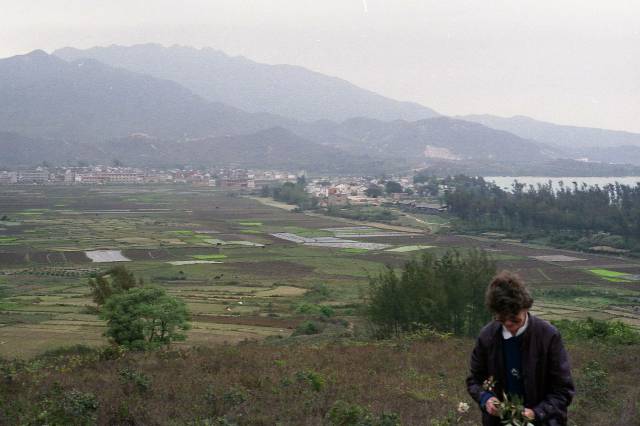 |
 |
 |
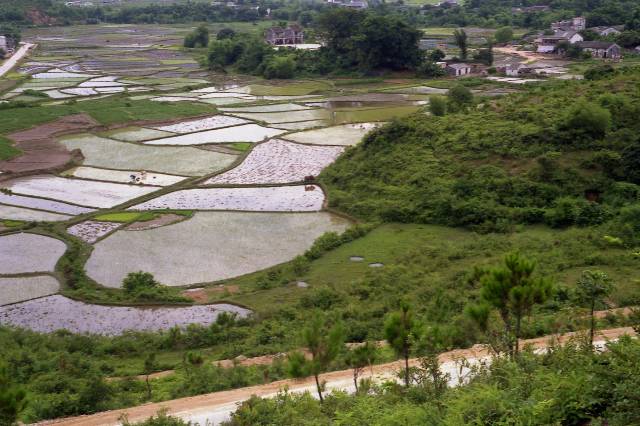 |
Farmland behind our housing colony and scenes of village on far side of the bay. |
|
Dotted amongst these cultivated bits and on rockier slopes were hundreds of tombs in groups or singly. Some were elaborate enclosures and others just urns standing askew amongst weeds and wild plants. Last Easter Monday, was also a special Chinese holiday and the border crossing was perhaps even busier than at the Chinese New Year – ancestors had to be honoured at their graves. Nearly every tomb or urn had little white papers fluttering under the weight of a stone and burnt out joss sticks were poked in holes. Firecrackers had also been used to frighten away evil spirits were also scattered around.
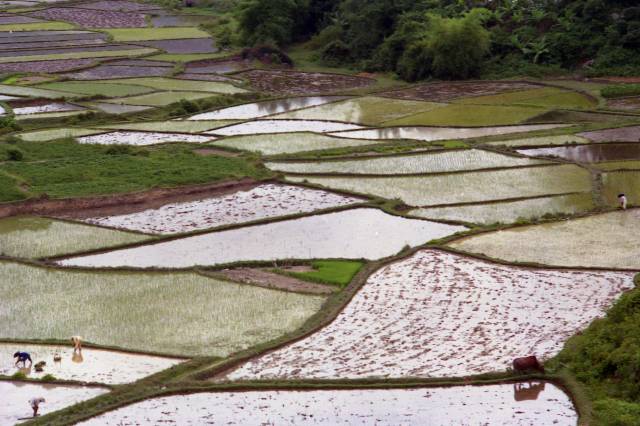 |
 |
Rice paddi fields some miles away from our housing colony. |
|
We spoilt ourselves and bought our first television set in nearly 30 years. Initially we received only one of H K programmes and no Mainland Chinese ones. The local Chinese people apparently only looked at H K television and indeed followed H K clocks. They were unaware when China changed its time for the seasons and our site followed this. Our maid, eighteen years old, would always arrive late on such days. She despite the one child to a family rule in China had four younger siblings. Many farming families well away from Beijing did not follow government rules.
Our Japanese partners later installed a satellite dish so that they could receive own language programmes and we, as a bonus, even more programmes from H K. The Tiananmen Square student democracy protest starting in April 89 and it’s brutal suppression early in June 1989 with hundreds killed and thousands arrested was reported by H K TV, including pictures of the intrepid protester deliberately walking slowly in front of an army tank and glancing at it occasionally. This would not have pleased the Chinese Authorities in Beijing but our lives well away from the capital were not affected although rumours about protestors trying to escape into H K were plentiful.
Bizarrely, we with a group of Britons, also saw the English Cup Semi Final football match in real time on TV between Liverpool and Nottingham Forest at Hillsborough in Sheffield in April 1989. The cameras continued for some time mainly in silence with bemused commentators after the game was halted showing victims being brought onto the pitch - then broadcasting stopped abruptly. Later it was confirmed that there had been a disaster with over a hundred spectators crushed and killed – strange to see this from so far away.
|
|
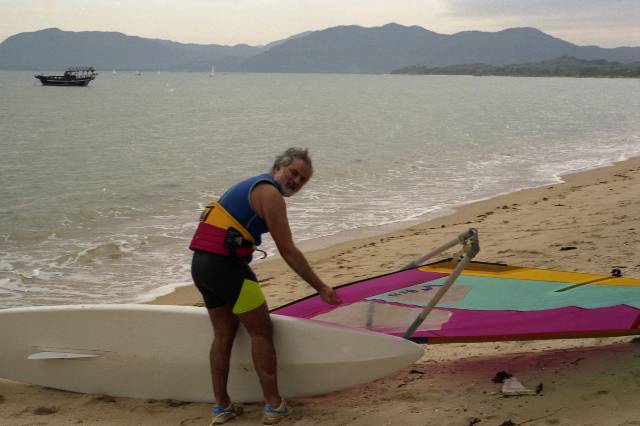 |
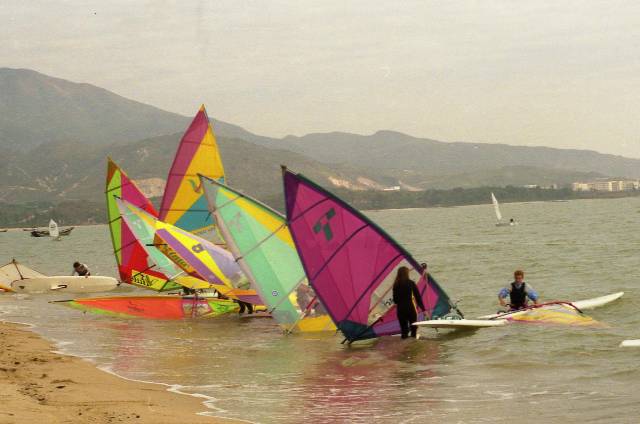 |
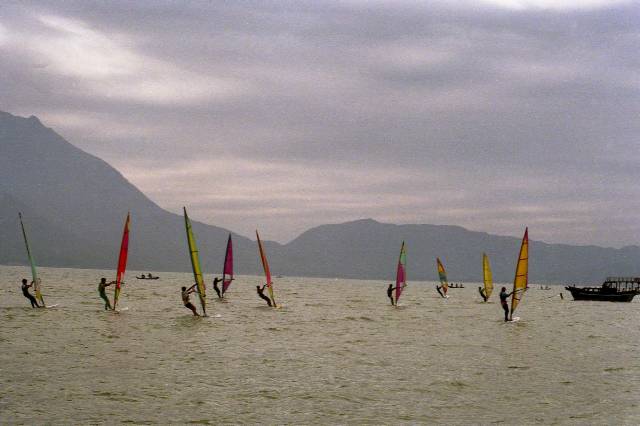 |
Junks to board sailing - just in front of the house. Bottom pictures of colourful regatta. |
|
I bought a board sail, foam rubber jacket and short pants (for protection against the cold). The bay in front of our house was large and shallow with its entrance miles to the left – an ideal safe area for windsurfing without danger of being blown out to sea. At 50 years of age, I took a long time to get the knack of hauling the sail out of the water and sailing smoothly away rather than falling foolishly on my back. I eventually sailed if somewhat un - adventurously. In summer to give the labour a break from the heat, lunch breaks were extended to 2½ hours and in my initial enthusiasm this was long enough to sail mid day and evenings. Later Ben on summer holiday learnt to sail in a fraction of the time and whizzed fearlessly the mile or so across the bay to the far side. Other intrepid board sailors made a point of venturing out in the ferocious winds arising before any anticipated typhoon with reduced sized storm sails – the speed was a buzz. On one occasion a sea snake with its head held high out of the water passed me - in my fright I tumbled off – the snake continued unperturbed on it’s way.
Cubby bought a washing machine to avoid using the central laundry in the compound. The laundry could only be used in the time slots allocated – risking interference with Bridge parties or other critical shopping or social activities. With the housing compound nearly full we inevitably ran short of fresh water. Until additional boreholes were sunk and a larger storage tank provided, water had to be trucked in from the site. For a few days we flushed toilets with buckets of seawater, also soaped ourselves inside the house and then plunged into the sea rinsing off. Later on problems continued with defective hot water cylinders and leaking roofs all giving inhabitants a chance to moan about the housing management’s ineptitude.
In free time there was much to do, we both played tennis and I again started playing squash, my opponent often being the French site doctor’s Chinese American nurse who gave me a competitive game. Cubby started assisting a Swedish wife giving English lessons to some of the French wives and also went to French lessons herself. A visiting teacher started giving weekly Chinese art lessons and Cubby participated finding the lessons somewhat more formal than what she had done some years earlier in South Korea. There was a club we did not frequent often but usually only went to on official company occasions. I never failed to be astonished how well fed expatriates loaded their plates with tasty food at buffets then unashamed at their greed left it half uneaten.
While Cubby still regularly went shopping in H K weekly, I seldom ventured there and preferred to relax in our colony, but sometimes had to go for expert but pricey dental treatment. A tooth shattered on a stone hidden in a spoon of rice had to be capped. Later an Australian dentist skilfully removed a wisdom tooth - he plunged a screwdriver like implement in from the side just below the tooth, twisted and levered it out in an instant. I had been carefully pre relaxed with sedatives and lulled with mood music.
Breaking the monotony we preferred to take several short holidays rather than long ones, this also suited our management as covering for staff was easier. We spent a few weeks in Paris in our apartment when my sister Ruth visited Europe from Cape Town. While many ‘package trips’ were available from Hong Kong into China these seemed to be disproportionately expensive and we were unsure whether we would enjoy them. Malaysia we nostalgically knew was relaxed and we were certain of having clean hotels, and good food and service.
We flew to Penang Island[5], explored a few days, then hired a car and drove across country to Kota Baharu on a fairly new road. There was still a slight threat from terrorists surviving the 1960ties ‘Emergency’ still hiding in the jungle, thus driving only in daylight was permitted. We negotiated nervously past some parts of the road where very high clayey embankments had spectacularly slip circled away leaving only narrow lanes edged by precipitous slopes falling into streams far below. Later we followed down the east coast being diverted by monsoon floods in some areas, this was not the season for tourists, the skies were overcast and threatening and the sea rough, stirred up and opaque not suitable for swimming. We reached Kuala Trengganu, a fervently Islamic area opposed to the relatively more conciliatory politics of Prime Minister Dr Mahathir Mahomed to other racial groups and religions. Then on to Kwantan, which we had visited before, and across the peninsula to historic Malacca on to Singapore where we caught a flight back to H K.
At an evening meal before Christmas 1988 with friends, Cubby stomach muscles hernia-ed and she was discomforted with strangulated intestines fortunately reducing on their own. The site doctor, consulted the next day, regarded this as serious as gangrene could set in. She was immediately sent to H K and operated on directly - we were covered by the site’s medical insurance. A day after the operation she returned to site in a large stretched Mercedes limousine avoiding trains and transfers but still wincing as she walked, clutching my arm, through immigration at a different crossing point. The journey took only 2 hours compared to the usual 3½ hours via train to Lo Wu.
The 6th of February 1989 was the first day of Chinese New Year – The Year of the Snake. Our maid, Agun, who had been given 4 days holiday came to visit Cubby, with some of her visiting friends from H K who fortunately could speak a little English, to wish her Kung Hei Fat Choi. Agun gave Cubby some deadly looking fireworks and a bag of mandarins (for health, good luck, and prosperity) and invited Cubby to visit her home tomorrow. Cubby had already given Agun some celebratory ‘red envelopes’ containing the obligatory new bank notes so she baked a large cake to bring with her. The Agun’s family, far from being a poor were living in the biggest and most modern house (ugly block with flat concrete roof) in the village. Her father worked as an interpreter on site (but not of spoken English).
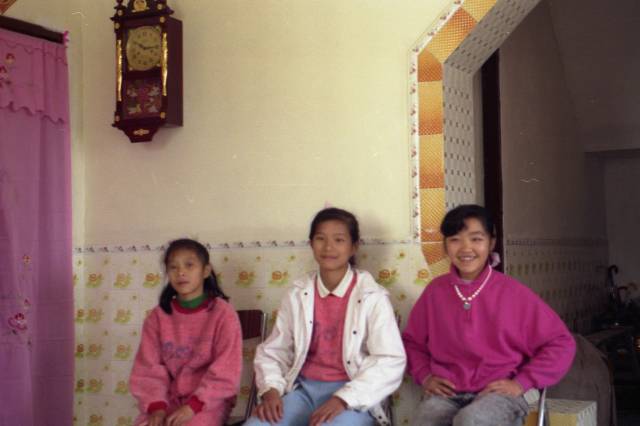 |
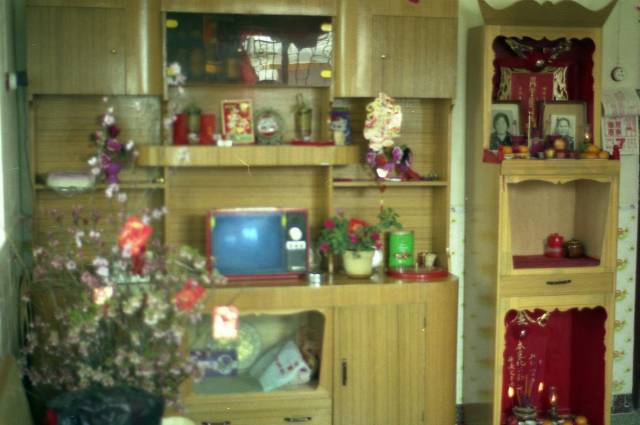 |
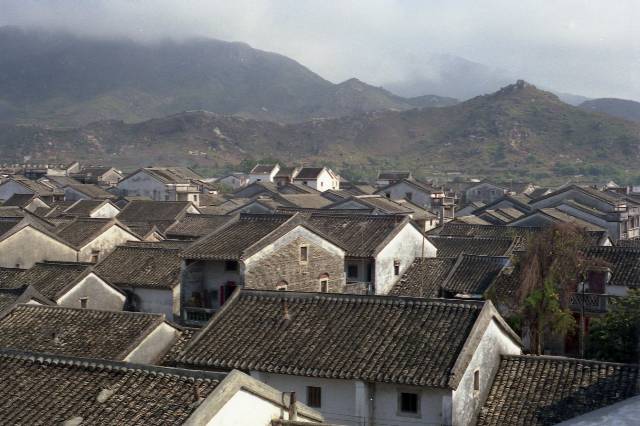 |
Our young Chinese maid Agun centre with friends. Interior of her parents house. Older pretty grey roofed houses. |
||
Agun’s friends took Cubby to visit their grandparents, 79 and 83 years of age who lived in an older attractive traditional house with sloping black tiled roofs with low ceilings, wooden beams and baskets with dried vegetables hanging from them. Over little glasses of hot water, boiled on a wood burning kitchen range, they explained that their son (the father of the friends) had swum to H K (from a boat) about 10 years ago and brought his wife and children there 2 years later. Back at Agun’s house Cubby was given tea and ‘cakes’ made of noodles stuck together with caramel. Both houses had several shrines with joss sticks burning and plates of ‘goodies’ as well as mandarins – it seemed very different to the frugal idea of China we had imagined.
Before lunch they followed a procession of colourful and noisy ‘dragon’, drummers and cymbalists to each village house where eardrum-shattering fireworks were ignited to chase away evil spirits. The meal was tasty and Cubby was constantly being given little titbits put in her bowl with their chopsticks.
The company bought a motorised junk, all large H K companies of any status seemed to have one. We joined parties of British expatriates on picnics and barbecues on outlying Islands. We remarked on the lack of seagulls compared to H K – had they all been eaten? Was seagull flesh fishy? We went to the H K rugby ‘sevens’ tournament in H K, faster moving and more exciting than the 15 man version. I was surprised to see the number of teams participating – the Wallabies and Kiwis[6] were there and many pacific islanders, the Fijians, Samoans, and Papua New Guineans whose supporters wore long yellow crocodile caps hanging down their backs. South Africa because of its Apartheid policy apparently was still boycotted.
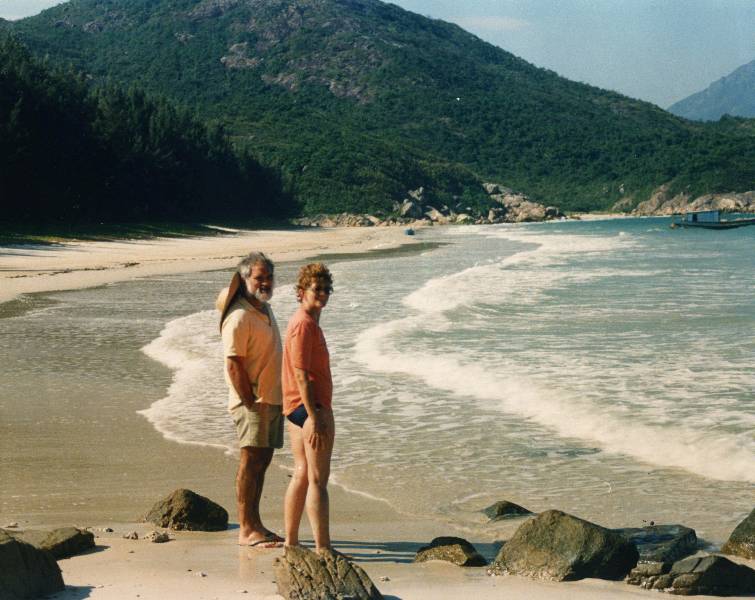 |
On the beach |
Cubby’s garden as usual was suffering badly, scorching summer winds killed most of the bigger shrubs each year, but narcissus planted as bulbs had come out in profusion and smaller things like chrysanthemums and dahlias survived.
While we were in China our children, eight years after we had left South Africa for a second time, were now grown up and on several occasions met their siblings and ourselves in France, Denmark, and England.
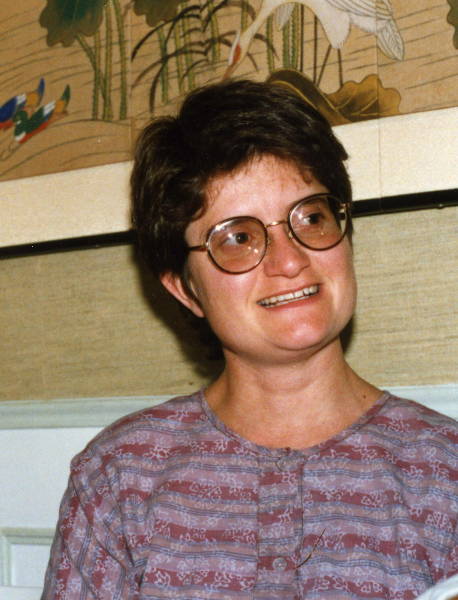 |
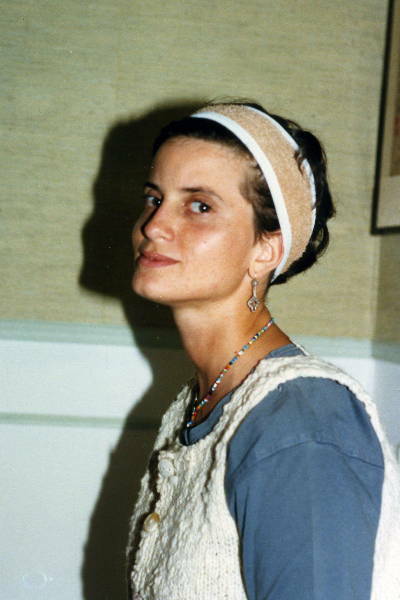 |
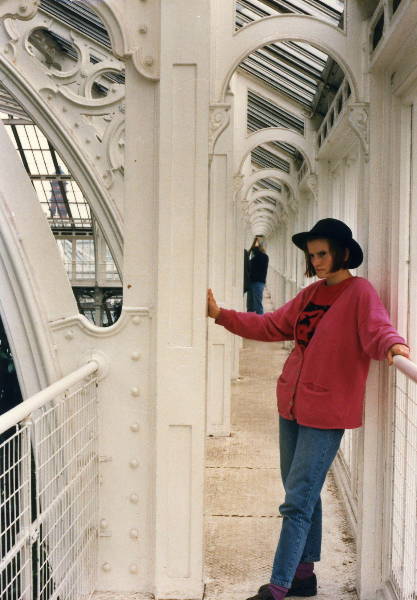 |
|
Nicky, Karen and Andrea visiting France at various times in 1988 |
||
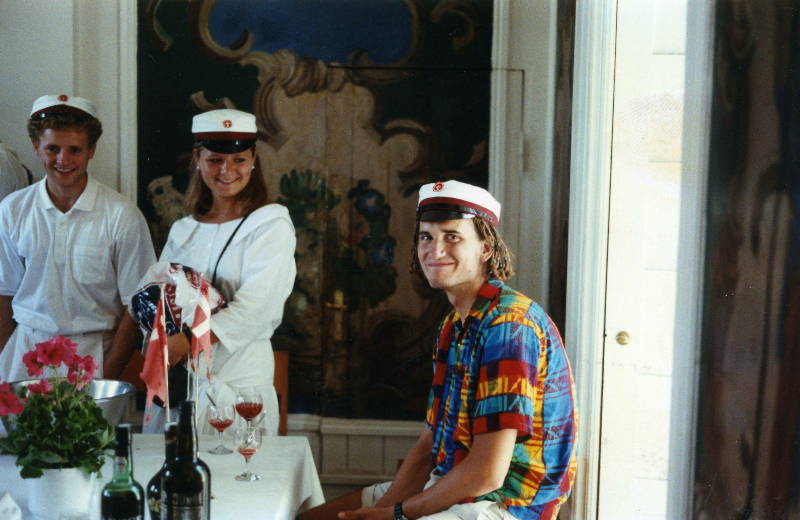 |
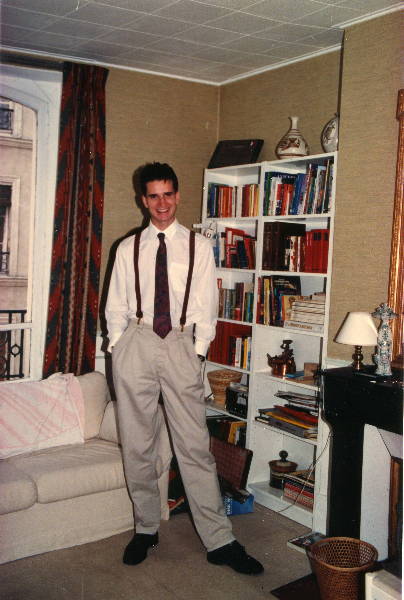 |
|
Ben celebrating passing his final exams at Bagsvaerd School in Demark and in our Paris apartment. |
|
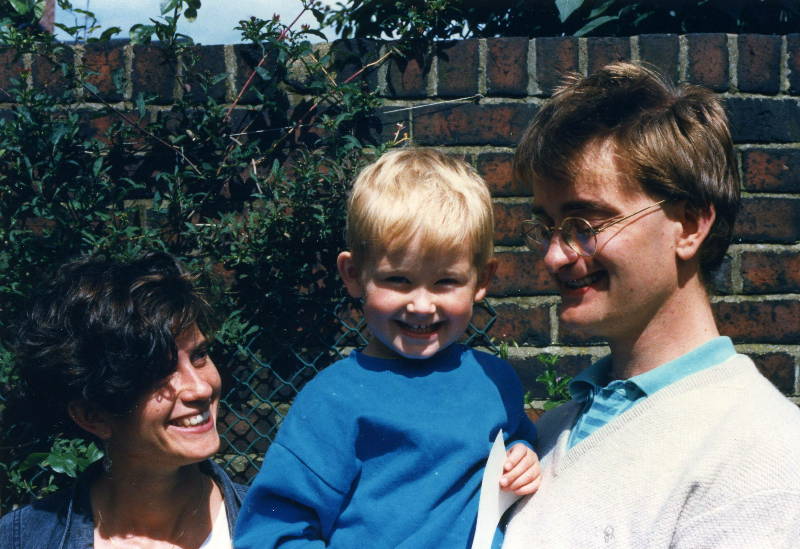 |
|
Karen with Christopher and his son Toby |
The job soldiered on. The quality of civil works in my view was even better than that on both the South African and Korean plants (which indeed were also well built). In April Spie informed that a replacement would take over from me and I left in August 1989 after a brief hand over to my successor.
We landed after dark on Penang and could not see much on our drive half way around the Island to the hotel.
The next day we joined a tour which circled the island and stopped at fishing villages, farming kampongs, a batik factory and a solitary rubber tree which gets sliced / tapped every time a tour comes through to show the latex bleeding. The west coast of the island is mountainous and had been planted with rubber. Apparently as rubber is labour intensive or prices had dropped, it had been replaced by fruit trees, in particular the malodorous Durian, a spiky looking green fruit the size of a large melon 15 to 20cm in diameter. In the season people from the islands chief city George Town throng to the durian plantations to buy, break and suck the delectable custard like pulp off the many pips – only the anti social bring the ponging fruit into their homes.
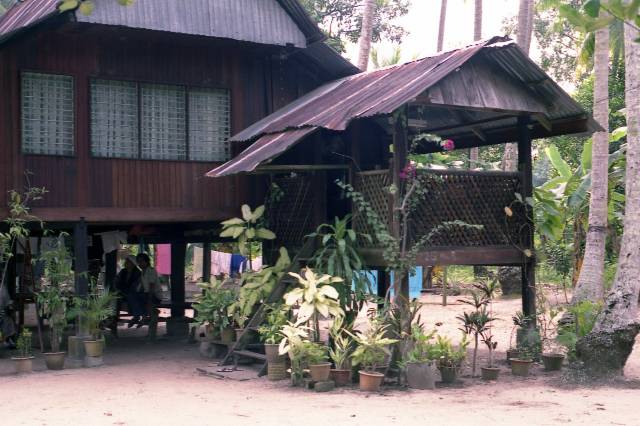 |
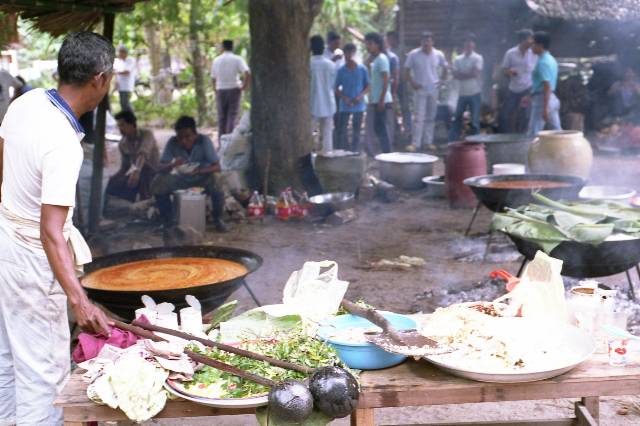 |
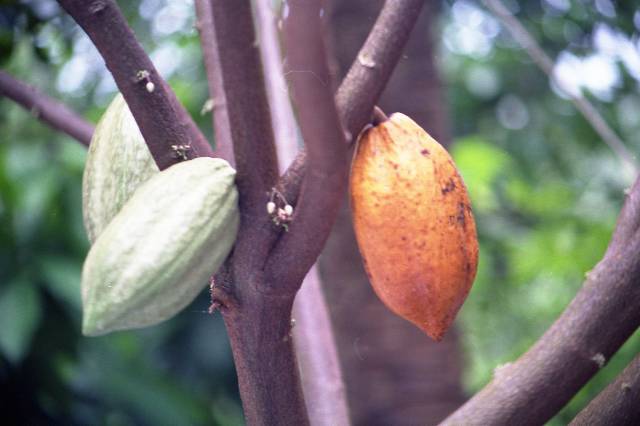 |
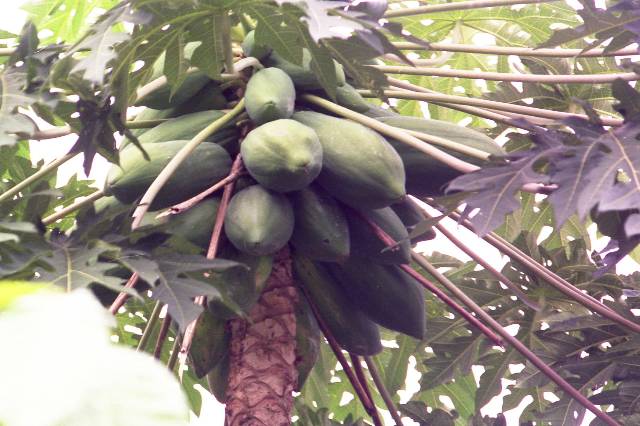 |
Kampong stilt house and festival meal being prepared. Cocoa pods and papaya fruit. |
|
Nutmeg fruit the size of yellow plums are also grown and harvested. The fleshy outer part is too bitter to eat but is sugared like mebos[7] - it had a pleasant nutmeg taste. Under this flesh the bright red lacy mace clings to the nutmeg kernal – the mace is removed from the kernal and dries yellow – both the mace and nutmeg are sold separately as seasoning and I replenished my stocks. Cloves, dried flower buds of a tropical tree were also cultivated. We saw a good bit of the countryside of Penang seeming not to vary much from Peninsula Malaysia, but being small did not have space consumed by regimented rows of palm oil.
Although I have seen batik factories several times before, the process at this one was described by a particularly good guide speaking clear English – hopefully even our mixed bunch of foreigners could understand.
63% of the people on the island are Chinese, some of whom judging by the size of their houses and gardens must be very wealthy. In fact the population is nearly the reverse of the mainland where there are 58% Malay, 32%Chinese and 10% Indian, mostly Tamils brought in by the British to work on plantations. It was pleasant returning to Malaysia, both the Chinese and Malays seemed friendlier than their ethnic groups we had met while in H K and Indonesia respectively.
We saw a few of the “sights” – the Snake Temple (Temple of the Azure Cloud) where venomous pit vipers lay curled over lintels, candlesticks and statuary in somnolent trances apparently due to the incense fumes hanging in the air. They awaken in the evenings and feed on eggs left by faithful Chinese.
Late in the afternoon we took the funicular railway up the 900metre high Penang Hill. Queuing 1½ hours to descend the sky darkened and George Town and Butterworth across the straits lay below spectacularly lit up. The 8km long bridge from the Island to the Mainland built by the Korean company Hyundai linked the two sides, a necklace of lights but ferries still crossed in about 20minutes.
There was a lot more we could have seen in George Town but our hired car, a local Proton a few years old, arrived as planned on Monday morning so we started toward Kota Baharu 400km away with Tony driving and me navigating. The journey took about 8½ hours, we lost our way between Butterworth and the start of the new northern road across the peninsula due to map errors and poorly marked routes – losing over an hour. It may have been easier to find the road if we had come from the south on more frequently used roads. Luckily a ‘one-pump’ petrol station assured us we were on the right route and not heading into Thailand.
I sampled their loo, three sides of a shack around a concrete slab with hole. The open side and the discharge chute sloped sharply away towards a well growing banana patch and a valley. Unfortunately I was wearing an overall top with bottom attached requiring complete undressing and then winding my clothes around my neck as there were no hooks. There was the usual barrel of water and a plastic dipper - loo paper was not used and avoided littering the valley below.
Once on the main route we sped up – the road was well designed and the views spectacular. But no man made structures can be guaranteed to resist the might of the elements. Even though every high embankment (possibly about 70m high) must have been compacted and the slopes planted with well growing vegetation, there were many landslides, which took great cavernous bites out of the road. In some cuttings sliding soil pressure from slopes above forced the road surface upward. Fortunately in only one very narrow spot were both traffic directions forced alternately to share the same lane running along a near precipitous frightening drop into valleys and streams below.
Apart from the odd whitish limestone rock outcrop the overall predominant land colours in Malaysia are brilliant varying shades of green, and startling reds. On this drive we saw lush heavily foliaged trees, secondary jungle, grown after logging. In between were ferns and aloes and red earth, chunks of hillside exposed by landslides. Occasional we saw solitary huge tree soaring high above the new canopy topping by small out of proportion clumps of foliage – the remnants of genuine first growth trees. Some of these giants were dead standing like huge skeletal bleached white open hands. The smoothness of their trunks apparently defeated the grip of parasitic flora, vines and creepers.
Descending to the plains on the east coast we saw signs of monsoon flooding. Small streams were now raging rivers and some flat fields although now dry were grey with mud. A mud tidemark on vegetation showed the level the floods had reached. The traditional way of building on stilts may have saved many homes, but did not stop roofs from leaking - there were rows of household belongings laid out to dry in the sun. Heavy continuous rains seemed to have halted for a moment but it is still the monsoon season and after short downpours the sun reappears again.
We had not booked a hotel in Kota Baharu, a small town, not a metropolis. The Japanese had landed there during the war and in 8 weeks had conquered both Malaya and ‘impregnable’ Singapore (British defences on Singapore were towards the sea and the invasion came from the relatively undefended land side). The sun had not set yet so we drove around until we found what seemed to be the most respectable hotel. There was a power cut when we entered and the lift was not working so we were escorted by candle light up the stairs, also serving as a depository for broken furniture, to our room. Our deluxe room was decorated in shades of green; the door was lime, the carpet khaki, the blankets emerald and the curtains a leaf colour. The furniture was sticky dark brown wood and the bottom of the enamel bath had worn through to the zinc. The western loo seat was of the thinnest flexible plastic and is probably often replaced. But the sheets on the beds were clean.
 |
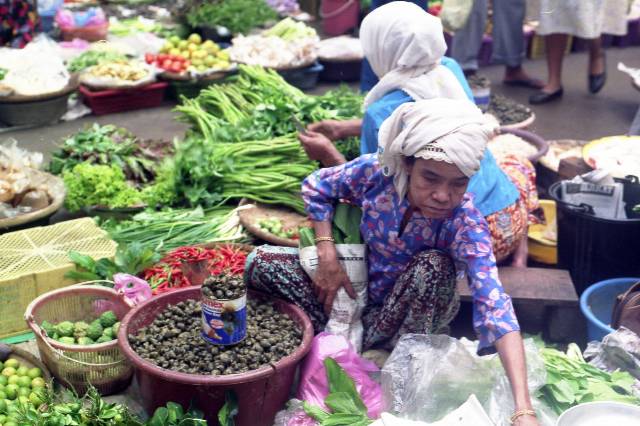 |
Market at Kota Baharu |
|
Very early next morning, avoiding the tropical sun, we walked along the riverfront with its old decaying, rain and mould stained colonial buildings and then to the market - a wonderful surprise. The market was in a domed new building, with a tinted yellow glass roof in the middle lighting an area almost like a theatre in the round. The merchandise made me swoon for a return job in Malaysia. There was a huge variety of sparkling fresh local fruit and vegetables predominately green and red in colour including chillies, tomatoes, carrots and snowy white cauliflowers. There were also meat, fish, rice, and pickled food sections. I felt discontented comparing this munificence with the paltry foods available at our local village market at Daya Bay in China. Here I also saw words in Malay and immediately recognised them - in China my vocabulary when shopping is very limited. In all I would prefer to live in Malaysia, but especially if I could transport our nice Daya Bay house and contents back with us.
We left K B about 9-45am for our next destination Kaula Trengganu about 3 hours away and dawdled down the coast road enjoying the countryside and hoping that we would not be stopped by floods - many of the local houses were standing on their stilt legs in ponds of water. About 40km from Kuala Trengganu approaching cars flashed their lights and made indecipherable signals. On rounding a bend the road in front disappeared into a lake. We retraced our tracks for about 3 km and found that there was a smaller road looping 50km inland which then lead us into K T from the southwest – we took an extra hour but at least we arrived.
We had pre booked for 2 nights into what we found to be an impressive modern hotel and were given a lovely room on the 7th floor overlooking a raging coffee au lait sea. There are obviously better (non monsoon) seasons to visit and to swim in the sea, but we could still cool down in the hotel’s pool. As in all hotel rooms in Malaysia, an arrow was fixed on the ceiling pointing towards Mecca. The crockery in the dining room had a vaguely familiar feeling and I then espied a tiny Bjorn Wiinblad signature (a well known Danish designer for whom my sister Dorte had once worked) and underneath the Rosenthal mark (the German manufacturers sign). The one thing we regretted was that it was not the season for huge sea turtles to lay eggs. They paddle themselves up the flat sandy beaches, then scoop out a hole and lay their eggs in August.
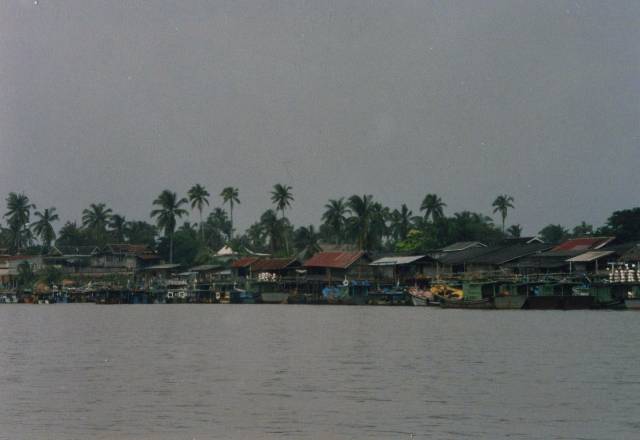 |
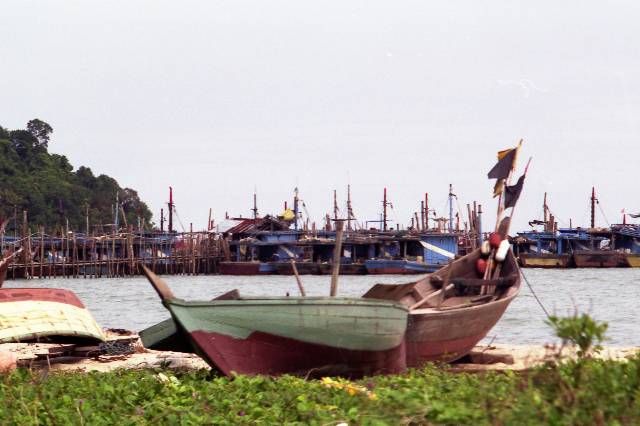 |
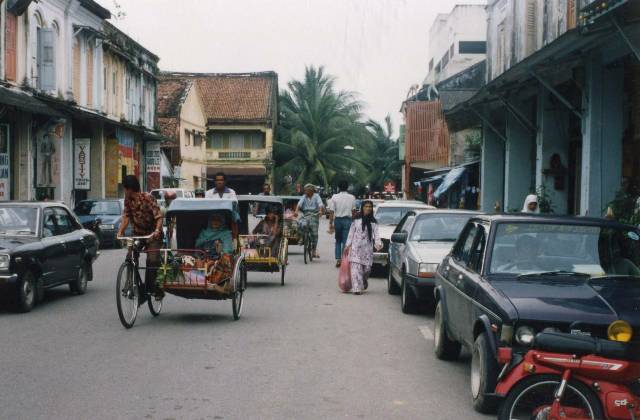 |
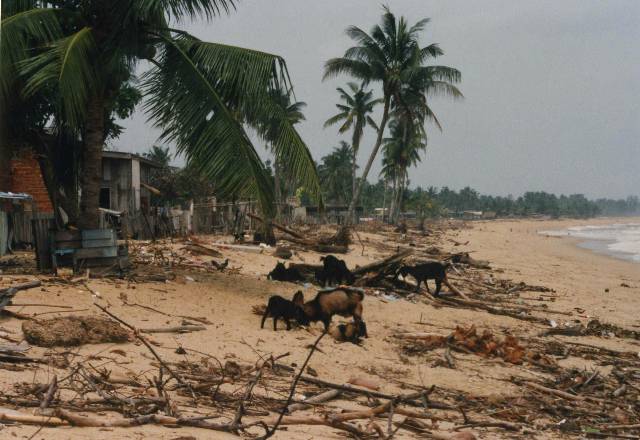 |
Stilt village on waters edge and fishing boat. Pedicabs in Kaula Trengganu. Goats scavenging on beach. |
|
Kaula Trengganu seemed a little less down at heel than Kota Baharu - there were many attractive shop-houses. We took a river bus across the wide river mouth (kuala means river mouth). The river itself was placid but we could see the ocean beyond thundering and crashing. On the other side there was a small fishing village with stilted piers jutting into the river. We beach-combed along the sands, looked at flotsam and relaxed.
On the way down to Kuantan our next destination we saw large new refineries and miles of townships for employees - signs of the off shore oil boom in the South China Sea. We passed an attractive hotel built of wood in traditional Malay style - closed for the monsoon season as was a Club Mediterranean complex. Approaching our destination Kuantan the road was once again blocked by floods, but again we found a way into the town on a secondary road.
We had visited Kuantan before in 1982 over Chinese newyear (also in the monsoon season) travelling up minor roads on the east coast from Johore Baharu where we lived when working on a power plant at Pasir Gudang. Nicky our eldest daughter visiting us from Cape Town and Benjamin our youngest son who stayed with us had accompanied us. We found that we were now booked into a hotel near where we had stayed in during that trip. This hotel had a few more ‘stars’ and was more luxurious with a swimming pool.
We decided to cut across country roughly southwest to Meleka (Malacca during Colonial times), avoiding Kaula Lumpur. The countryside was largely oil palm, ranging from long established plantations with huge palms to miles of hills with tiny new sprigs and also areas being cleared of secondary forests to plant even more palms. The route between Segamat and Melaka was on small hilly secondary roads taking us through small villages untouched by tourists, no advertisement hoardings and apparently no TV - aerials were not seen.
We decided to spend our ‘spare’ night in Malacca and booked into the same hotel, Shah Beach Hotel 6 km outside the town. We had stayed there in 1981 with Ben and Christopher our eldest son visiting from Oxford where he was doing A levels, and Andrea our youngest daughter visiting from school in Paris. We explored the areas we had previously missed finding the ‘Portuguese’ quarter where they still spoke Portuguese as their home language, but otherwise the people appeared no different to other Malays. Apparently the government was taking over the Catholic schools so the language may be lost in a few generations. We walked out on a narrow timber stilted jetty just above water level used by ‘Portuguese’ fisherman into the Melaka Straits, a very busy shipping route running between peninsula Malaysia and Sumatra (where once we had also worked). We did not see any of the navy blue sailed fishing boats which had filled the canal in Maleka or the mouth of the Muar river further down the coast in 1981, a glimpse of a past lifestyle – progress had unfortunately caught up.
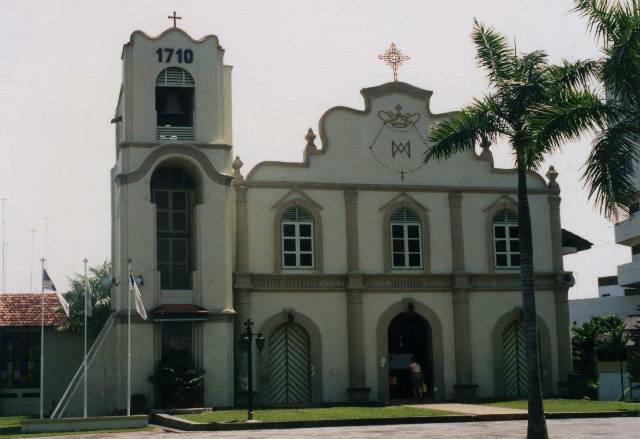 |
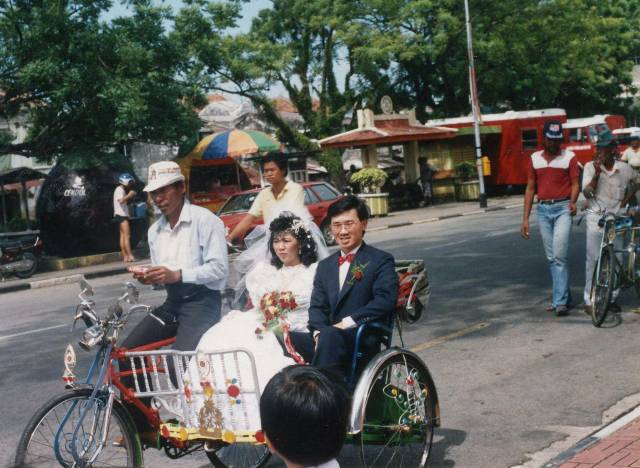 |
|
|
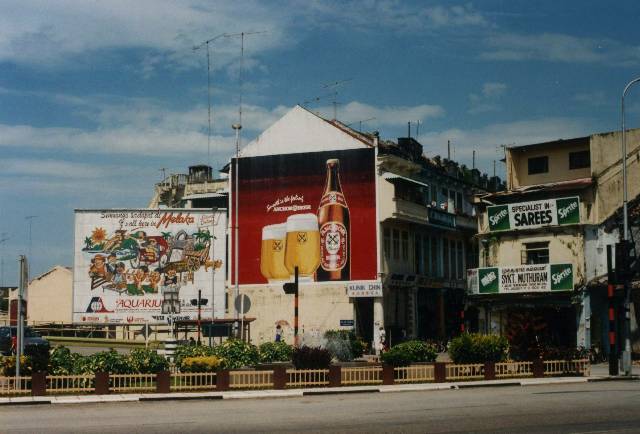 |
Mallaca - Catholic church mainly used by the Malaysian community of Portuguese descent. Chinese wedding couple in pedi-cab. Fishing jetty stretching into the Straits. Cooling beer for thirsty travellers. |
|
Our last lap to Johore Baharu was familiar, we had travelled this route on our previous visit to Melaka passing pretty wooden stilt houses with flowers in pots on their steps. There appeared to be fewer Morris Minor cars parked at these homes than on our journey 7 years earlier – probably Japanese cars or locally made ones (Protons) had replaced this ageing model from a Colonial era. Johore Baharu, a scruffy town when we lived there, had had a facelift – everything was much smarter and green trimmed grass lined the roads where previously there had been tired soil and weeds. It seemed that Johore Baharu was now catching up with it’s neighbour Singapore.
We crossed the familiar causeway, also passing through the two sets of immigration and customs. Benjamin had done this every school day when we lived in JB. There were no English Language schools in JB (or generally in Malaysia), but in Singapore it was the Island States language. I had shared ferrying several boys across with some local mothers who could afford to have their children educated in English at private schools rather than in Malay.
We reached our hotel early in the afternoon. The hotel apparently did not have a cheap room to match our travel agents bargain booking and upgraded us without extra charge into a rather sumptuous duck egg blue room with a very posh bathroom and an elegant escritoire at which I wrote this letter. We walked to some of my favourite haunts, the Indian shopping centre where I bought some lovely silk. Later we returned to the hotel and lazed around the pool hungrily waiting for our evening meal – we had as usual skipped lunch after having too filling breakfasts.
The hotel’s restaurant required Tony to wear a tie or we could eat in the Coffee Shop as long as we were ‘smart casual’. He had no tie and we felt very casual - not chic. We ate across the road at a Rasa Singapura a hawker’s bazaar where food stalls are permanent and clean. We wandered around the many stalls choosing what we fancied. Colourful, cheap and tasty food - we ate Chinese sweet cooked pork and shrimp wantons, stuffed Indian chapatis, mutton briani and topped this off with Malay fried bananas and iced fresh lemon juice – all very appetising.
We left the next day for Hong Kong on our way back to Daya Bay.
[1] See description of holiday taken in Malaysia at the end of this document
[2] The old airport on Kowloon peninsula later replaced
[3] At this time we were not yet required to use the smaller ruby soft covered European Union pattern passport requiring more frequent renewals.
[4] Although the official currency in China was Remimbi, HK$ were freely accepted in areas of Guangdong Province close to Hong Kong.
[5] An edited transcript of Cubby’s letters to her parents describing this Malaysian holiday is attached at the end of this chapter.
[6] Several of the players in the New Zealand and Fijian sides played in the Commonwealth games tournament in 2002 in Manchester 13 years later.
[7] A South African dried fruit confection
index memoir -
homepage - contact me at